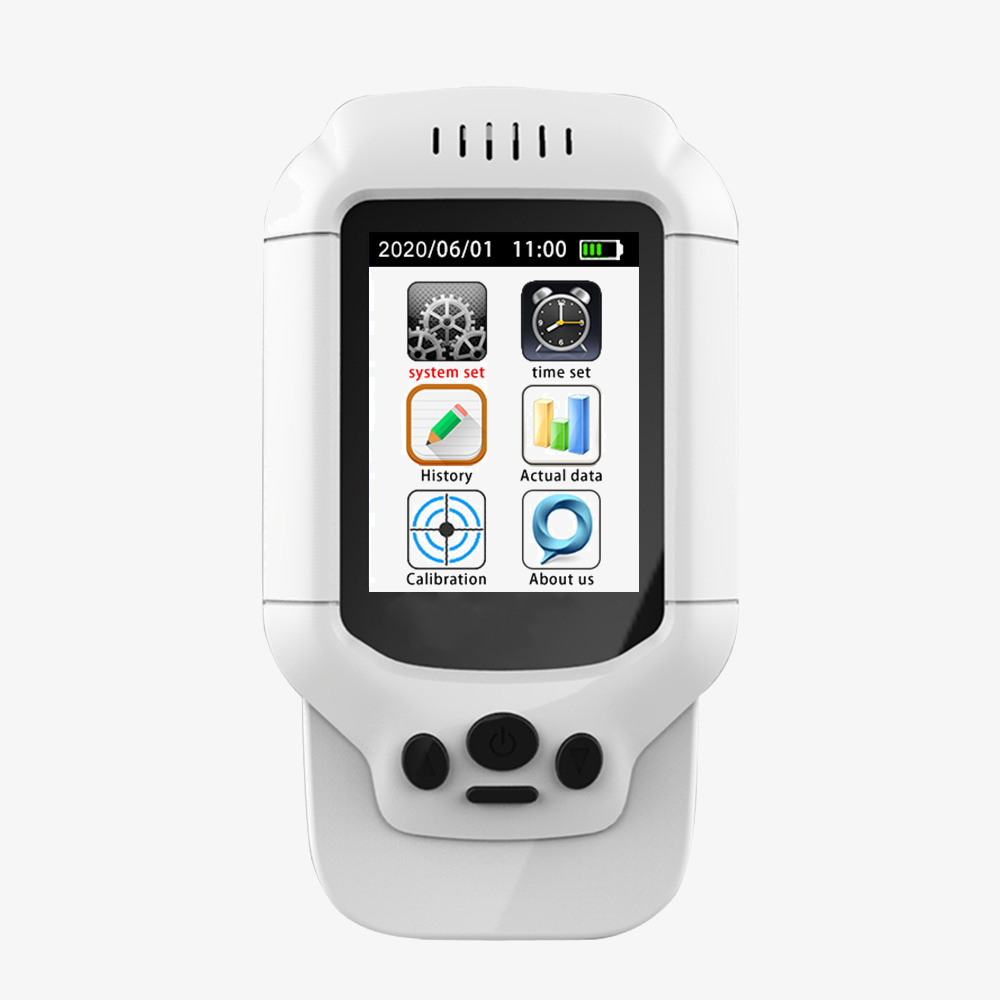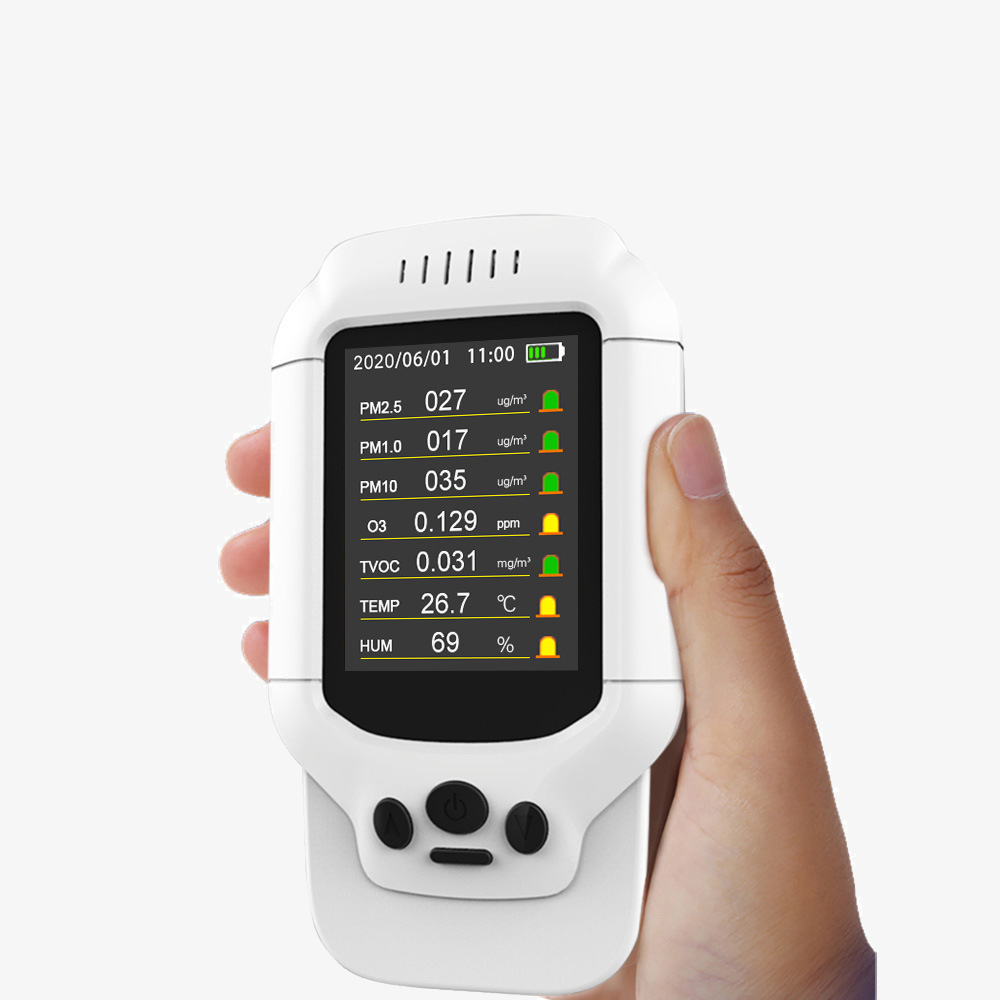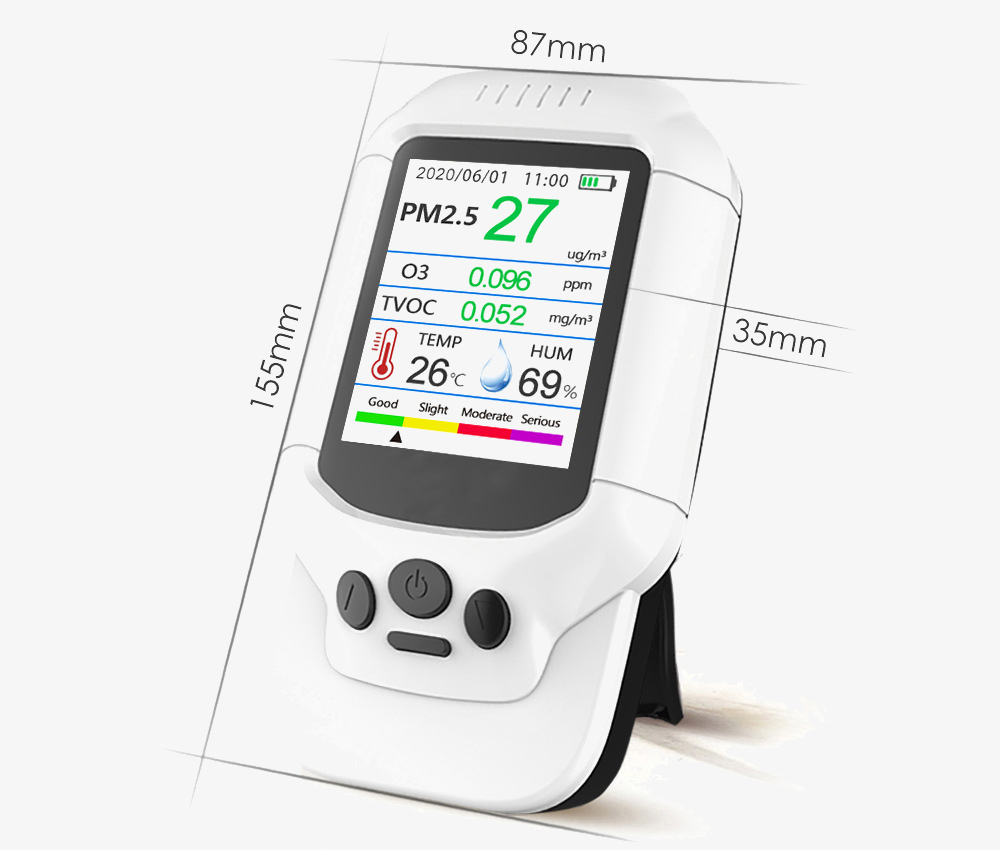Portable air quality monitor is designed for measuring PM2.5, PM1.0, PM10, HCHO, TVOC, AQI, temperature and humidity at home/office/car. Rechargeable Li-battery, 2.8" color LCD display, compact size and light weight, easy operation, quick response and accurate detection.

Portable air quality monitor with integrated detection
- sisco portable air quality detector supports various test including PM2.5/PM1.0/PM10, formaldehyde, TVOC, AQI, temperature and humidity
- With a 2.8" color LCD display, 320*240 pixels, easy to read
- The monitor is convenient for operation with direction keys.

Handheld air quality detector is easy to operate and read.
- The monitor has 4 different interfaces, user-friendly.
- Adoptsindependent sensors, and high-speed RM processor, fast response and accurate detection.
- Large capacity rechargeable lithium battery, the air quality tester can work for a long time.
Applications
The air quality monitor is suitable for monitoring institutions, detection and management companies, decoration companies, construction companies, workshops, factories and mines, and can also be used for formaldehyde, ammonia, (benzene, benzene series) in households, teaching, laboratories, production workshops and living places. , TVOC on-site quantitative detection.

| Model | SISCO-AIR-DM502 |
| Test Item | PM2.5, PM1.0, PM10, HCHO (Formaldehyde), TVOC, AQI, Temperature, Humidity |
| Measure Range | PM2.5: 0-999μg/m³ HCHO: 0.001-1.999mg/m³ TVOC: 0.001-9.999mg/m³ AQI: 0-500 |
| Temp. & Hum. Detection Range | Temperature: -20℃ ~ 50℃ Humidity: 20% ~ 90%RH |
| Detection Principle | PM2.5/PM1.0/PM10: Laser scattering HCHO: Electrochemistry sensor TVOC: Semiconductor sensor Temp. & Hum.: Temperature and Humidity sensor |
| Sampling Time (PM2.5) | 1.5s |
| Detection Area | 50m2 |
| Operating Temperature | -10℃ ~ 50℃ |
| Relative Humidity | 20% ~ 85%RH |
| Storage Temperature | -10℃ ~ 60℃ |
| Display | 2.8" LCD screen, 320 * 240 pixels |
| Power Supply | Rechargeable Li-battery |
| Material | ABS |
| Product Size | 155*87*35 mm |
| Product Weight | 200g |
| Standard Accessories | Main device, USB charging cable, user manual |
| Certification | CE |
Dimension (Unit: mm)

Q1: What air quality monitor?
A1: Air quality monitor is a product that can detect formaldehyde, PM2.5, TVOC and temperature and humidity in real-time, small and exquisite, easy to carry. Through its internal original imported sensor, it can accurately measure the pollutant concentration and calculate the air quality index AQI, and alarm when the concentration exceeds the standard.
Q2: How does an air quality monitor work?
A2: Air quality monitors are equipped with several sensors to detect different types of pollutants. Electrochemical sensors detect oxygen levels and the presence of toxic gases by reducing oxygen through electrodes and measuring its concentration. Particle detectors detect dust, pollen and mold by passing a laser through the air inside the sensor. Based on the intensity and array of light beams, the monitor can determine the concentration of particles in your home. The monitor displays the current air condition of the indoor space. Some have color coding or numbering systems to indicate hazard levels.
A3: What is an air quality monitor used for?
Q3: The air quality detector can be used to detect various harmful substances such as PM2.5/HCHO/TVOC/AQI/PM1.0/PM10, and can also test indoor air quality such as humidity and temperature. If the indoor air quality is poor and there are many harmful substances, an obvious prompt will be given, and it is recommended that you start to purify the air. At the same time, many air detectors are gradually becoming more intelligent, which can be remotely observed and controlled by mobile phones, which is more convenient.
Tips: Why is the PM2.5 value different from the value posted online?
The location and conditions of the test are difficult to coordinate with the weather station, the weather station has several sampling points in the city, and the measurement data of each sampling point are also very different. The sampling points at this location are strictly required: 3 to 30 meters in height, good air circulation, and not close to the chimney, furnace and other obvious sources of pollution. There are no tall buildings, trees, or other obstacles that can hinder the flow of ambient air around the instrument.
Thank you for buying industrial test and measurement equipment on SISCO.com, all products sold by SISCO and the partner cover a 12 months warranty, effective from the date of receiving the products.
What is covered?
SISCO is responsible for providing free spare parts, and free technical support to assist the customer to repair the defective products until the problem is solved.
What is not covered?
- Product purchased from anyone other than a SISCO store or a SISCO authorized reseller.
- Expendable parts.
- Routine cleaning or normal cosmetic and mechanical wear.
- Damage from misuse, abuse or neglect.
- Damage from use of parts other than SISCO approved.
- Damage from use outside the product’s usage or storage parameters.
- Damage from use of parts not sold by SISCO.
- Damage from modification or incorporation into other products.
- Damage from repair or replacement of warranted parts by a service provider other than a SISCO authorized service provider.
- Damage caused by the application environment not meeting the product usage requirements and the failure to perform preventive maintenance.

